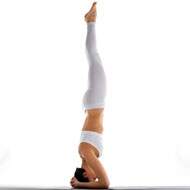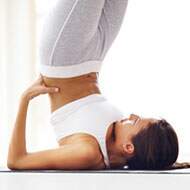Supported Headstand (Salamba Sirsasana)
Salamba Sirsasana or the Supported Headstand is a pose in yoga that is most suited for a person who has reached the intermediate level in yoga. The term 'Salamba Sirsasana' is made up of two Sanskrit words.
'Salamba' which means 'with support' and 'Sirsa' which means 'head'.
Steps :
- Start off in Balasana (Child's Pose). Rest your head on either a blanket or a mat.
- Now kneel on the floor and clasp your hands together. Place your head in between your fingers and rest your forearms on the ground/mat.
- While inhaling, move off the floor and move your feet so that they are closer to your head. Your heels should be pointing upward and press your shoulder blades in to your back.
- Now exhale and raise your legs perpendicular to the floor and keep your thighs turned inward slightly while doing this.
- Press your tailbone firmly back against the base of your pelvis. Do not arch your back.
- Stretch your legs upward.
- This pose can be held about 10 seconds or longer depending on your comfort level.
- Come out of this posture by exhaling and ensure that both your feet touch the floor at the same time.
Precautions :
- Do not practice this pose if you have either had a back or neck injury, suffer from headaches, have high blood pressure or low blood pressure or have an existing heart condition.
- This pose should not be performed while menstruating.
- It is not advisable to practice this pose while pregnant, unless you are familiar and quite experienced in doing this pose, before pregnancy.
Beginner's Tip :
The beginner's tip for Supported Headstand involves practicing this pose against a wall. This prevents putting too much weight on the beginner's neck and head.
Benefit To Body Part :
- It strengthens the entire body.
- It tones the abdominal muscles as well as the legs.
- It stimulates the nervous system.
- It stimulates the pituitary and pineal glands.
- It strengthens the lungs.
- It improves digestion.
- It strengthens the spine and arms and legs.
- It helps to relieve the symptoms of menopause as well.
- It can relieve the buildup of fluid in the legs and feet.
- The pose lets healthy blood flow into the brain.
Therapeutic Applications :
- This pose can help treat many ailments like headaches, insomnia, asthma, diabetes, hay fever, sinusitis, anxiety and insomnia.
- It can help improve posture and digestion.
- It helps to relieve stress and mild depression as well.
- It also helps to treat problems linked with various parts of the body such as the liver, reproductive organs, stomach, kidneys, and intestines.
- The symptoms of menopause are relieved after doing this pose.
- It helps to treat problems like tonsillitis, palpitations, bad breath, the common cold as well as a persistent cough.
- It may help to reverse the effects of memory loss and lethargy as well.
- It helps to increase clarity and mental awareness as well.
Variations :
The variations for Supported Headstand include a variation called Eka Pada Sirsasana (Foot behind the Head Pose). Your left leg should be kept perpendicular in this pose and your right leg should be parallel to the ground. Keep your two sitting bones together and then start rotating from the hip in order to turn the right leg back to a neutral position. Hold this position for about 10-30 seconds. Turn the right leg back into the perpendicular position and then repeat the above steps for the other leg.
Preparatory Poses :
- Downward Facing Dog (Adho Mukha Svanasana)
- Supported Shoulder stand (Salamba Sarvangasana)
- Standing Forward Bend (Uttanasana)
- Hero Pose (Virasana)
Follow Up Poses :
- Downward Facing Dog Pose (Adho Mukha Svanasana)
- Child's Pose (Balasana)



